Key Takeaways and Your Quick Answer
You clicked because you want the real story behind Paris’s clubs-what started it, what changed it, and where to feel it now. Here’s the straight answer: Paris built modern nightlife by blending cabaret showmanship, jazz freedom, disco spectacle, and techno’s underground grit. If you chase it right, you can experience all four in one weekend-cabaret at dusk, jazz in a cave, a disco temple, then a 5 a.m. warehouse. Not every legend is alive, but the DNA still is.
- TL;DR: Paris nightlife began with 19th‑century cabarets, exploded with 1920s jazz, went decadent in the disco 70s, then reinvented itself with 90s techno and 2010s warehouses. Today you can still trace the whole arc in a single city stroll.
- Where to feel it now (2025): Cabaret shows in Pigalle; jazz cellars in the Latin Quarter; big‑room house/techno under cinema neon; late‑night raves on the city’s edges.
- Costs: Cabaret €90-€220+ (show; dinner raises price). Club entry €10-€30; cocktails €12-€18; bottle service from €150-€300. Jazz clubs €15-€35 cover.
- How to plan: Pick an era theme per night; book show tickets early; arrive at clubs before 1 a.m.; mind dress codes near the Champs‑Élysées; carry a valid ID.
- Pro move: Mix eras-cabaret at 9 p.m., jazz at 11 p.m., club by 1 a.m., afters toward dawn. That single arc mirrors 140 years of Paris’s rhythm.
Jobs you likely want to get done after clicking:
- Understand the timeline: who started what, and when.
- Map the neighborhoods that shaped the scene.
- Figure out where to go today that still feels historic.
- Know prices, door policies, and how to avoid rookie mistakes.
- Get a simple route (or two) you can actually follow this weekend.
Quick definitions to keep us aligned: cabaret is seated, show‑driven nightlife (think dancers, live numbers), while a nightclub is a stand‑up dance floor with DJs or bands and a late closing time. Paris has both, often side by side.
The Story: How Paris Invented Nightlife
Paris didn’t invent staying out late, but it did invent the modern idea of going out as an art form. The blueprint starts in the Belle Époque-cabarets turned nightlife into spectacle. Then jazz made it wild and improvisational. Disco made it theatrical again, with a bolder, inclusive crowd. Techno stripped it back to pulse and light, then rebuilt it in warehouses and cinemas. Stitch those eras together and you get the city’s signature vibe: style, risk, and a weirdly warm sense of community at 3 a.m.
Belle Époque (1880s-1914): Cabarets like the Moulin Rouge and their rivals blended satire, dance, and risqué humor. Electricity and posters turned shows into must‑see culture. Artists and misfits mixed with high society-an early version of the VIP rope, minus the wristbands.
The 1920s jazz surge: After World War I, Americans brought jazz and a freer dress code. Montmartre and Montparnasse got new life. Black American performers, queer creatives, and Parisian bohemians fused styles. Intimate cellars and dance halls made the night feel personal-no balcony seats separating you from the action.
Post‑war cellars (1940s-50s): Saint‑Germain‑des‑Prés turned philosophical cafés into jam spots. Jazz caves-literal stone vaults-offered heat, sweat, and swing. Dancing shoulder‑to‑shoulder felt like a quiet rebellion against rules.
The 1960s to early 70s: Rock clubs and yé‑yé dance floors brought young Paris into the game, but the big shock arrived with disco.
Disco decadence (late 70s-80s): The era of costume, glitter, and velvet ropes. Le Palace became Paris’s own Studio 54-fashion editors, drag artists, punks, all on one floor. Celebrity and subculture danced together, and that mix became the city’s calling card.
House/techno (90s-2000s): The Grand Rex cinema’s club nights pushed electronic music center‑stage. DJs became the new headliners. Here, the crowd is the show: lights on skin, hands up, sweat everywhere. The vibe turned less “watch us” and more “be it.”
2010s to now: Pop‑ups and warehouse parties brought the edge back. Boats turned into dance floors, old factories became temples of bass, and Sundays started to rival Saturdays. After the pandemic pause, promoters doubled down on sound quality, safer spaces, and genre diversity.
If you want receipts, look at the public record: posters and playbills in Gallica (Bibliothèque nationale de France), TV segments in INA (Institut national de l’audiovisuel), and city archives documenting venue licenses and cultural policy. Biographies of performers and DJs fill in the personalities-the people who risked money and sleep to make strangers dance.
| Era | Signature Vibe | Typical Venues | Sounds/Stars | What You Can Do in 2025 |
|---|---|---|---|---|
| 1880s-1914 (Belle Époque) | Show-led nights, satire, cancan | Cabarets, revue theaters | Revue orchestras, chanson | Book a cabaret show for the classic opener |
| 1920s (Jazz Age) | Improvisation, interracial & queer-friendly scenes | Dance halls, cellars | Hot jazz, swing | Catch a live jazz set in a historic cave |
| 1945-1960 | Basement culture, post-war energy | Latin Quarter cellars | Bebop, big band | Early evening swing classes + live band |
| 1978-1985 (Disco) | Glitz, costumes, fashion crowd | Iconic discos & theaters | Disco, new wave | Dress up for a retro disco night |
| 1990s-2000s | DJ-led, sound-first dance floors | Cinema basements, big rooms | House, techno | Plan a late entry (1-2 a.m.) at a flagship club |
| 2010s-2025 | Pop-ups, boats, warehouses | Riverside, industrial sites | Hardgroove to melodic techno | Follow promoters on socials for last-minute parties |
Neighborhood shorthand helps: Pigalle and Montmartre are your cabaret-and-disco twins; the Latin Quarter is your jazz time capsule; the Grands Boulevards area is where cinema meets club; the edges of the city host the late‑late industrial raves.
Not every legend is intact. Some clubs are now hotels, theaters, or myths-but the spirit migrates. When a famous room closes, the sound and the crowd tend to regroup nearby. Paris nightlife survives by moving a few blocks and changing its name.

How to Explore Paris Club History Today
Here’s a practical plan to feel the past without getting stuck in a queue or a tourist trap.
Two plug‑and‑play routes, depending on your mood:
- Route A: “From Feathers to Four‑Four” (Cabaret → Jazz → Club). Start with a classic cabaret show in Pigalle, walk or ride to the Latin Quarter for a cellar jazz set, then finish at a big‑room house/techno spot before 1:30 a.m. You get ceremony, musicianship, and a long dance floor in one go.
- Route B: “Underground All Night” (Jazz → Vinyl Bar → Warehouse). Hit an early swing set, warm up at a music‑first bar where the DJ is within arm’s reach, then ride to a warehouse party. This route values intimacy over glitter.
How to pick venues (a quick decision tree):
- Want a seated spectacle with costumes? Choose cabaret. Book online, pick show‑only if you’re budget‑conscious, dinner if you want the full ritual.
- Want live musicians and dancing? Choose a jazz cellar; check the band style (swing vs bebop). If you see swing lessons before the show, you’ve found a friendly entry point.
- Want a late night with DJs? Choose a club. Scan the lineup: local residents = community vibe; touring headliner = peak energy but bigger queue.
- Not sure? Follow the promoters. Paris runs on collectives-if the same name curates a lineup you like, trust their next event, even in a new space.
What to expect during a night out in 2025:
- Timing: Parisians arrive late. Cabaret starts 7-9 p.m. Jazz hits 9-11 p.m. Clubs warm around 1 a.m., peak 2-4 a.m., and some push close to dawn on weekends.
- Dress: Anything goes in jazz cellars. Cabaret is smart casual. High‑profile clubs near the Champs may prefer polished shoes and a clean silhouette. Techno warehouses care more about attitude and consent than labels.
- Door policies: Doormen want a simple story-two or three friends, you know the lineup, you’re not wasted. Be polite, keep chatter short, have ID ready. If you’re in a huge group, split before the line.
- Inside etiquette: Don’t shove. Don’t film people on the dance floor without asking. If a place has a “no photo” sticker, it’s not a suggestion.
Pricing and booking basics (typical, 2025):
- Cabaret: €90-€220+ per person for show; add €70-€150 for dinner packages. Book a week ahead for weekends, more during holidays.
- Jazz cellars: €15-€35 cover; drinks €8-€14. Small rooms fill fast-arrive 20-30 minutes before showtime.
- Nightclubs: €10-€30 entry; student or early bird tickets can be cheaper online. Cocktails €12-€18; beers €7-€10; bottled water €3-€5. Bottle service from €150-€300 at premium spots.
- Warehouses/pop‑ups: Presales only, often €15-€25. Location revealed by email or app on event day. Bring a portable charger; you’ll need the QR code at the door.
Safety and smooth sailing tips:
- Keep your phone in a zipped pocket or crossbody. Pickpockets love crowded lines and dance floors.
- Know your exit route before you need it. In older basements, stairs can be tight and stone floors get slick.
- Hydrate. Paris tap water is fine; many clubs offer free carafes if you ask at the bar. If not, buy water early to avoid end‑of‑night queues.
- Consent culture is strong-use it. If someone’s bothering you, tell staff. If a venue has a “safe team,” they’re there to help, not judge.
- Late transit: Night buses and ride‑hails run, but waits spike after 2 a.m. Budget for a ride at least once, especially if you’re far from the center.
Finding historically resonant spots (without a time machine):
- Cabaret with heritage: Classic revue houses still deliver the old‑school spectacle with modern lights and tighter run times. Pick a late show for a more adult crowd.
- Jazz caves with history: Look for vaulted rooms that advertise swing or big‑band nights. If there’s a dance floor and a horn section, you’ve hit pay dirt.
- Cinema‑to‑club DNA: Big rooms under vintage marquees nod to the 90s wave of cinema‑club culture-look for lineups curated by veteran French DJs.
- Warehouse crews: Follow promoter collectives rather than venue names. When leases change, the party moves but the curators (and their sound engineers) don’t.
Rule of thumb if you’re overwhelmed: Pick one era per night. Friday: cabaret + jazz. Saturday: club + afters. Sunday: a sunny guinguette or riverside closing party. Your body-and your photos-will thank you.
Comparisons, Checklists, FAQ, and Next Steps
Not sure whether you want velvet seats or a concrete floor? Here’s a clear comparison.
| Experience | Cabaret (Paris) | Nightclub (Paris) |
|---|---|---|
| Format | Seated show, choreographed numbers | Standing dance floor, DJ or live set |
| Best for | First-timers, celebrations, spectacle | Music lovers, dancers, late-night crews |
| Cost | €90-€220+ (show), dinner extra | €10-€30 entry, drinks extra |
| Dress | Smart casual to glam | From streetwear to chic; scene-dependent |
| Timing | Evening start (7-10 p.m.) | Late start (1-2 a.m.), peak 2-4 a.m. |
| Photos | Often allowed, sometimes limited | Varies; some “no photo” policies |
| History hit | Belle Époque roots | Disco to techno lineage |
Quick planning checklist:
- Pick your era (Cabaret, Jazz, Disco, Techno) and build the night around it.
- Buy tickets in advance for cabarets, warehouses, and big headliners.
- Eat before the club; you won’t find much food at 3 a.m. inside.
- Carry a physical ID (passport or EU ID). Photos on phones can fail at the door.
- Split big groups into pairs at the entrance; regroup inside.
FAQ
- Is the famous disco scene still alive? The original rooms changed, but the spirit survives. You’ll find disco‑leaning nights in renovated spaces and theaters, often with dress‑up themes. The fashion crowd still shows up-Paris loves a look.
- Where can I hear “true” Paris techno? Follow established local collectives and lineups featuring French residents. If the flyer lists a proper sound system brand and a curfew past 5 a.m., you’re in the right lane.
- Do I need to speak French? Not really. A polite “Bonsoir” and “S’il vous plaît” go a long way. Staff are used to mixed crowds.
- Can I do cabaret and club in one night? Yes. Aim for an early cabaret, quick drink nearby, then walk or ride to a club for 1 a.m. arrival.
- What’s the legal age and ID policy? Expect 18+ checks at clubs. Always bring valid government ID; some doors are strict.
Next steps by persona:
- History buff: Spend an hour on Gallica (BnF) looking at cabaret posters before you go. It’ll sharpen your eye for details in the showrooms.
- First‑time visitor: Book one marquee cabaret, one jazz night, and one club with a friendly door. That gives you breadth without stress.
- Music‑driven traveler: Choose nights by lineup, not venue. Paris is curator‑led-follow the promoters you vibe with.
- Budget explorer: Do a jazz cellar where the cover includes a drink. For clubs, grab early‑bird tickets online and arrive before peak.
- Style seeker: Aim for a disco‑leaning theater night and dress the part. Paris notices effort.
Troubleshooting common snags:
- “I got turned away at the door.” Regroup. Switch to a music‑first spot or a promoter event with presale tickets. Keep voices low in line, and let one person do the talking.
- “The queue is insane.” Check a smaller venue or bar with a dance floor for a warm‑up; return after 2 a.m. when turnover starts.
- “It’s all tourists.” Move a neighborhood or two outward, especially along the canal or inner ring. Follow resident‑DJ nights.
- “Drinks are pricey.” Pre‑game with dinner, then nurse a beer or water between cocktails. You’re paying for the room, not just the glass.
- “No address for the warehouse.” That’s normal. Watch your email/app the day of the event. If the drop pin changes, trust the organizer update, not crowd guesses.
A note on sources and credibility: The backbone of this history comes from public archives (Archives de Paris), printed programs and posters (BnF Gallica), televised nightlife segments and interviews (INA), and decades of Paris press coverage. Industry memoirs and DJ interviews fill in the late 20th‑century club years. If you’re deep‑diving, look for exhibitions by Paris Musées and oral histories from performers and promoters-you’ll see the same beats echoed across time.
One last north star: Paris nightlife works like a relay race. Cabaret hands the torch to jazz, jazz passes to disco, disco to techno. If you chase the handoff-two or three stops in a single night-you’ll feel why this city never really sleeps. It just changes outfits.
P.S. Nerdy trick I use: curate a “timeline playlist” for your weekend-cancan to swing to disco to house. Play it as you move between rooms. Your steps will write themselves into the city’s soundtrack.
And yes, the keyword you came for is this: Paris nightclubs history. You just walked it, era by era. Now go dance it.





Jackie Brosio
August 28, 2025 AT 14:21History note: Paris clubs were survival spaces for marginalized people long before they became tourist postcards.
The cabaret rooms, the jazz cellars and even the early discos were safer havens for queer people, Black American musicians, and anyone who wanted to slip out of daytime rules. Those places taught music, fashion, and code all at once, and that legacy still influences how nights open and close here. If you walk into a Latin Quarter cellar you can still feel the compressed air and the way the room demands a shared breath. That tension made the nights intense and intimate and it created a social contract where people looked out for each other. The article nails the eras, but the emotional labor behind them is what mattered most on the ground. Promoters and performers risked money, safety, and social standing to keep the parties interesting, and that risk culture passed down to newer crews who prize sound quality and consent. A practical travel tip to respect that lineage is to treat every venue like it has a memory: step lightly, dress in a way that honors the vibe, and don't film strangers in vulnerable moments. Bring cash for smaller cellars, tip the band at the end, and say thank you when a door staff helps you out. If you want to feel the relay race of eras, follow a promoter collective for multiple events across neighborhoods rather than hopping obvious tourist spots. That way you meet the people still carrying the flame and you avoid the performative rewrite of history that sometimes happens when venues rebrand for visitors. Also note the logistics: old basements often have narrow stairs and sober lighting, so pace your shoes and your expectations. When a famous room closes, the sound system and the crew usually resettle elsewhere within weeks, which means the best way to track real history in the present is to follow curators, not addresses. If you are there on a tight schedule, pick one night and go deep instead of trying to sample everything. Let the city show you one thread properly and you will leave with a feeling instead of a photo album. This is what staying out late in Paris has always been about-an exchange of trust and taste that survives through decades of change.
Max Cossío
August 30, 2025 AT 16:21That timeline made me want to pack my bags right now and shout about glitter like it was a religion.
Paris still wears its history like an overdressed coat and I am here for every feather and neon stripe.
Kyle Levy
September 1, 2025 AT 18:21Context is crucial; the piece lays out the eras but misses a few structural truths that matter for anyone who cares about cultural lineage.
The commodification of certain rooms over the last two decades has consequences; it means access is mediated by money and influence, and that is not neutral. When venues pivot to tourism-first models the original communities lose not only space but also the informal apprenticeship systems where younger DJs and MCs learned craft. Local promoters, often unpaid for months, shoulder risk that tourists never see. Preservation of sound systems, booking ethics, and equitable pay should be non-negotiable priorities if history is to be more than nostalgia. Archival work is not optional either. Public records, oral histories, and properly catalogued ephemera are the only way to check revisionist timelines. If you value authenticity, support initiatives that document who actually made the scene possible, and contribute, even in small ways, to those archives. Posterity requires civic memory, not just highlight reels. The dance floor is a cultural artifact as much as a social one, and it deserves stewardship. That is not moralizing, it is insisting on continuity.
Kevin Poston
September 3, 2025 AT 20:21Solid, practical tips in that planning checklist are what most visitors actually need.
Arrive late, split groups at the door, and respect local etiquette and the night will reward you. Also, hydration and exit planning are underrated essentials.
Scott Randall
September 5, 2025 AT 22:21Bring a printed ID; phones die and copies fail.
Thiago Gonçalves
September 8, 2025 AT 00:21Love the route ideas and the timeline vibe, makes planning feel doable 🙂
For anyone on a tighter budget, local student nights and smaller vinyl bars give excellent value and a real scene feel. Bring a small power bank and a foldable map or screenshot the venue details because sometimes signal vanishes underground. Enjoy the music and keep the weekend flow easy on the feet.
Tim Orrell
September 10, 2025 AT 02:21There is a dialectic at work between form and function in these spaces, where aesthetics and utility collide to produce meaning.
Cabarets instantiate theatricality as civic ritual, laying down a performative grammar that future clubs adopt and transmute. Jazz caves exemplify liminality, where improvisation becomes a mode of social negotiation and the room itself influences musical syntax. Disco introduced extravagance as social equalizer, democratizing spectacle while codifying new tastes. Techno, by contrast, tends toward structural minimalism, privileging temporality and physical synchronization over curated spectacle, and thus creates new communal schemas based on rhythm and density. Reading Parisian nightlife through this lens reframes venue changes as shifts in semiotic regimes rather than mere fashion cycles. That reframing helps explain why certain collectives survive: they are custodians of a particular syntax of social interaction, not just playlists. Understanding that will change how one curates a visit or archives a memory.
Clay Caldwell
September 12, 2025 AT 04:21Nice unpacking of form and function, and the note about collectives is key.
Collectives do more than book nights, they maintain community norms and train new talent. Following them is the best way to find genuine nights and avoid plasticized tourist offerings. Expect shifting locations but consistent curatorial voice when you track a trusted collective.
anjan tiwari
September 14, 2025 AT 06:21This feels a bit romanticized but still useful 🙂
Not every promoter is noble and not every warehouse has good sound, so temper your myth-hunting with basic skepticism. Go in with both curiosity and a grain of salt.
Jazzmen McCray
September 16, 2025 AT 08:21Agree with the emphasis on jazz caves and their intimate power, that era still breathes in the city.
When you hear a horn in a low room in Saint‑Germain you are listening to techniques and call‑and‑response patterns that migrated from American clubs, and that lineage is active in how musicians trade phrases on stage. Support those rooms by buying the cover and a round, then stay to listen and clap on the right beats. Musicians notice appreciative audiences and that sustains the scene. If you stumble into a late swing lesson, stay and try it out; the room shifts when people participate. Lastly, protect the music by not filming whole sets; short clips are fine, but recording entire sets chews the livelihood of small bands. Keep the vibes live and present.